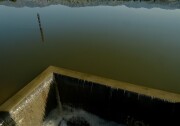A Lot Of Snow Is Starting To Melt, And LA’s Aqueduct Could Get Overwhelmed

In any given year, about 50% of L.A.’s water travels from the Sierra Nevada through the L.A. aqueduct to our taps. The rest of it often comes from the Colorado River aqueduct and the State Water project.
This year, though, we’ve got so much water stored in the snowpack in and around Inyo and Mono counties that the full supply to the city will come through the aqueduct, at least through the summer, according to the Los Angeles Department of Water and Power.
“The city demand is a certain amount, but we have way over the city demand that we have to manage,” said Adam Perez, LADWP aqueduct manager up in Bishop. “Right now we are sitting and trying to manage about double of what we would see under a normal water type of year.”
A normal year would mean about four to five hundred thousand acre feet of water to manage. This year, LADWP's anticipating more than a million acre feet. The largest amount they’ve ever had to deal with.
-
Introducing a new series: LAist City Treks
-
Why you won't find the best sunscreens here
-
New video shows alleged assault
“We’re in good shape,” Perez said. “At the peak of the melt, this is where we could be overwhelmed.”
The melt’s been manageable for the aqueduct so far thanks to a cool start to spring, but things are picking up, with peak flow expected in June. And if it’s a hot day and a storm comes along upstream, the influx of water could overwhelm the system.
LADWP crews have been prepping for the torrent of water in a number of ways, including by clearing spreading grounds, which will help both manage the flow of water and recharge groundwater for pumping later.
They say they’ve also been staging equipment, including excavators, which will work to pull sediment out waterways as it builds up. The end goal: keep as much water flowing as smoothly as possible.
Water will also flow to agriculture and mitigation projects that LADWP has long had on the books.
If the system is overwhelmed, water could be released via emergency spill gates near Bishop and Lone Pine. Owens Lake is also an option to help mitigate flooding.
“I hope this is a once-in-a-career moment,” said Perez.
-
Sandhill cranes are returning to the Lake Tahoe basin after a century long hiatus in what many say is a conservation success story.
-
Jackie’s partner, Shadow, refuses to abandon their unviable eggs, despite her attempts to nudge him along.
-
We do have some of the same types of buildings here.
-
Switching to an electric heat pump water heater can save you money and help the state avoid power outages.
-
The state's parks department is working with stakeholders, including the military, to rebuild the San Onofre road, but no timeline has been given.
-
Built in 1951, the glass-walled chapel is one of L.A.’s few national historic landmarks. This isn’t the first time it has been damaged by landslides.









